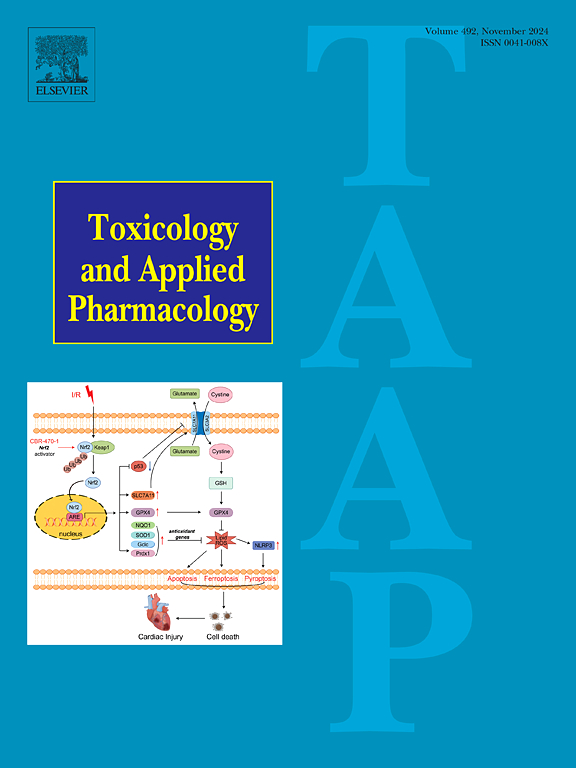Telaprevir attenuates caspase-11-dependent pyroptosis in mouse heart following ischemia/reperfusion via inhibition of MALT1/TRAF6 pathway
IF 3.3
3区 医学
Q2 PHARMACOLOGY & PHARMACY
引用次数: 0
Abstract
Pyroptosis is one of the major forms of cardiomyocyte death following ischemia/reperfusion (I/R). Mucosa-associated lymphoid tissue lymphoma translocation protein 1 (MALT1)/Tumor necrosis factor receptor associated factor 6 (TRAF6) pathway is involved in cardiomyocyte pyroptosis in mouse heart following I/R, and telaprevir, a hepatitis C virus protease inhibitor, has been predicted as a potential inhibitor of MALT1. This study aims to explore the effect of telaprevir on I/R-induced cardiomyocyte pyroptosis. The C57BL/6J mouse was subjected to 45 min-ischemia plus 24 h-reperfusion to establish the myocardial I/R injury model, while H9c2 cardiomyocytes were exposed to hypoxia for 8 h plus reoxygenation for 24 h (H/R) to simulate the I/R pathological process in vitro. Compared to the control group, pyroptosis was significantly increased in the I/R-treated mouse heart or the H/R-treated cardiomyocytes, evidenced by the elevated GSDMD and caspase-11 cleavage. Compared to the vehicle, telaprevir reduced myocardial infarcted size and cleavage of caspase-11 and gasdermin D (GSDMD) in mouse heart following I/R and cultured cardiomyocytes subjected to H/R in a dose-dependent manner. Mechanistically, telaprevir inhibited the recruitment of TRAF6 by MALT1, concomitant with the reduced recruitment of caspase-11 by TRAF6, and in turn, attenuated caspase-11 K63 poly-ubiquitination and activation, which was further confirmed by knockdown of TRAF6. Based on these results, we concluded that telaprevir could protect mouse heart against I/R injury by reducing caspase-11-dependent pyroptosis through inhibition of MALT1/TRAF6 pathway.

Telaprevir通过抑制MALT1/TRAF6通路减轻小鼠心脏缺血/再灌注后caspase-11依赖性焦亡。
焦亡是心肌细胞缺血再灌注(I/R)后死亡的主要形式之一。粘膜相关淋巴组织淋巴瘤易位蛋白1 (MALT1)/肿瘤坏死因子受体相关因子6 (TRAF6)通路参与I/R后小鼠心脏心肌细胞焦亡,而丙型肝炎病毒蛋白酶抑制剂特拉匹韦已被预测为MALT1的潜在抑制剂。本研究旨在探讨替拉韦对I/ r诱导的心肌细胞焦亡的影响。C57BL/6 J小鼠45 min-缺血+ 24 h-再灌注建立心肌I/R损伤模型,H9c2心肌细胞缺氧8 h +再氧24 h (h /R)模拟体外I/R病理过程。与对照组相比,I/ r处理的小鼠心脏或H/ r处理的心肌细胞焦亡明显增加,GSDMD和caspase-11切割水平升高证明了这一点。与对照药相比,替拉匹韦在I/R和H/R培养的心肌细胞中以剂量依赖的方式减少心肌梗死面积和caspase-11和gasdermin D (GSDMD)的裂解。从机制上讲,telaprevir抑制MALT1对TRAF6的募集,同时TRAF6对caspase-11的募集减少,进而减弱caspase-11 K63多泛素化和激活,这一点通过TRAF6的敲低进一步证实。基于这些结果,我们得出结论,telaprevir可以通过抑制MALT1/TRAF6通路减少caspase-11依赖性焦亡,从而保护小鼠心脏免受I/R损伤。
本文章由计算机程序翻译,如有差异,请以英文原文为准。
求助全文
约1分钟内获得全文
求助全文
来源期刊
CiteScore
6.80
自引率
2.60%
发文量
309
审稿时长
32 days
期刊介绍:
Toxicology and Applied Pharmacology publishes original scientific research of relevance to animals or humans pertaining to the action of chemicals, drugs, or chemically-defined natural products.
Regular articles address mechanistic approaches to physiological, pharmacologic, biochemical, cellular, or molecular understanding of toxicologic/pathologic lesions and to methods used to describe these responses. Safety Science articles address outstanding state-of-the-art preclinical and human translational characterization of drug and chemical safety employing cutting-edge science. Highly significant Regulatory Safety Science articles will also be considered in this category. Papers concerned with alternatives to the use of experimental animals are encouraged.
Short articles report on high impact studies of broad interest to readers of TAAP that would benefit from rapid publication. These articles should contain no more than a combined total of four figures and tables. Authors should include in their cover letter the justification for consideration of their manuscript as a short article.

 求助内容:
求助内容: 应助结果提醒方式:
应助结果提醒方式:


